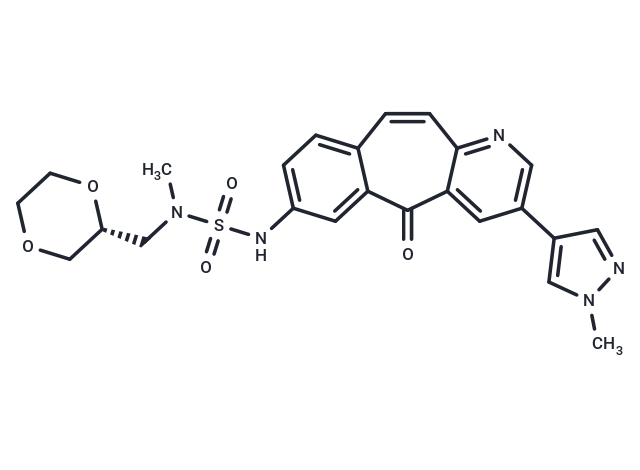Shopping Cart
- Remove All
 Your shopping cart is currently empty
Your shopping cart is currently empty

MK-2461 is a novel inhibitor that targets multiple proteins and competitively binds to ATP sites, specifically inhibiting the activated c-Met protein with an average inhibitory concentration (IC50) of 2.5 nM.

| Pack Size | Price | Availability | Quantity |
|---|---|---|---|
| 1 mg | $48 | In Stock | |
| 5 mg | $123 | In Stock | |
| 10 mg | $196 | In Stock | |
| 25 mg | $382 | In Stock | |
| 50 mg | $582 | In Stock | |
| 100 mg | $887 | In Stock | |
| 200 mg | $1,190 | In Stock | |
| 1 mL x 10 mM (in DMSO) | $136 | In Stock |
| Description | MK-2461 is a novel inhibitor that targets multiple proteins and competitively binds to ATP sites, specifically inhibiting the activated c-Met protein with an average inhibitory concentration (IC50) of 2.5 nM. |
| Targets&IC50 | c-Met:2.5 nM |
| In vitro | MK-2461 also potently inhibits FGFR1, FGFR2, FGFR3, KDR, TrkA, TrkB, and Flt4 with IC50 of 65 nM, 39 nM, 50 nM, 44 nM, 46 nM, 61 nM, and 78 nM, respectively. Compared with wild-type c-Met, MK-2461 more potently inhibits the activity of oncogenic c-Met kinase mutants such as N1100Y, Y1230C, Y1230H, Y1235D, and M1250T with IC50 of 1.5 nM, 1.5 nM, 1.0 nM, 0.5 nM, and 0.4 nM, respectively. MK-2461 binds more strongly to phosphorylated c-Met than to unphosphorylated c-Met. MK-2461 potently inhibits ATP-induced autophosphorylation of the COOH-terminal docking domain of c-Met, but not the activation loop. In contrast, MK-2461 inhibits phosphorylation of the activation loop of FGFR2 (Y653/Y654) in Kato III cells and PDGFRα (Y849) in H1703 cells with IC50 of <0.3 μM. MK-2461 inhibits HGF-induced mitogenesis of 4MBr-5 cells with IC50 of 204 nM, and HGF-induced migration of HPAF II cells with IC50 of 404 nM, as well as HGF-induced branching tubulogenesis of MDCK cells. In addition, MK-2461 potently inhibits IL-3-independent proliferation of 32D cells transformed with Tpr-Met or Tpr-Met (Y362C) mutant with IC50 of ~100 nM. MK-2461 significantly inhibits the proliferation of a large panel of tumor cell lines, especially potent against tumor cells harbored genomic amplification of MET or FGFR2. [1] |
| In vivo | MK-2461 treatment significantly inhibits c-Met (Y1349) phosphorylation in GTL-16 tumors with IC50 of ~1 μM. Oral administration of MK-2461 at 10 mg/kg, 50 mg/kg, and 100 mg/kg twice daily as well as 200 mg/kg once daily effectively suppresses tumor growth of GTL-16 xenografts in mice by 62%, 77%, 75%, and 90%, respectively. Similarly, MK-2461 treatment at 134 mg/kg twice daily inhibits the growth of NIH3T3 tumors harboring c-Met single nucleotide mutants T3936C and T3997C, by 78% and 62%, respectively. [1] |
| Kinase Assay | Time-resolved fluorescence resonance energy transfer assay: The c-Met–catalyzed phosphorylation of N-biotinylated peptide (EQEDEPEGDYFEWLE-CONH2) is measured using a time-resolved fluorescence resonance energy transfer assay. [2] The MK-2461 IC50 for Ron, Mer, Flt1, Flt3, Flt4, KDR, PDGFRβ, FGFR1, FGFR2, FGFR3, TrkA, and TrkB are determined using time-resolved fluorescence resonance energy transfer assays similar to the c-Met kinase assay. |
| Cell Research | Cells are exposed to various concentrations of MK-2461 for 72 hours. The viability of tumor cells is measured using the ViaLight PLUS kit.(Only for Reference) |
| Alias | MK2461 |
| Molecular Weight | 495.55 |
| Formula | C24H25N5O5S |
| Cas No. | 917879-39-1 |
| Smiles | CN(C[C@@H]1COCCO1)S(=O)(=O)Nc1ccc2ccc3ncc(cc3c(=O)c2c1)-c1cnn(C)c1 |
| Relative Density. | 1.45 g/cm3 |
| Storage | Powder: -20°C for 3 years | In solvent: -80°C for 1 year | Shipping with blue ice. | |||||||||||||||||||||||||||||||||||
| Solubility Information | DMSO: 92 mg/mL (185.65 mM), Sonication is recommended. H2O: < 1 mg/mL (insoluble or slightly soluble) Ethanol: < 1 mg/mL (insoluble or slightly soluble) | |||||||||||||||||||||||||||||||||||
Solution Preparation Table | ||||||||||||||||||||||||||||||||||||
DMSO
| ||||||||||||||||||||||||||||||||||||

Copyright © 2015-2025 TargetMol Chemicals Inc. All Rights Reserved.